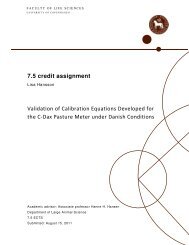Innovative Technology and Sustainable Development of Organic - 1.
Innovative Technology and Sustainable Development of Organic - 1.
Innovative Technology and Sustainable Development of Organic - 1.
You also want an ePaper? Increase the reach of your titles
YUMPU automatically turns print PDFs into web optimized ePapers that Google loves.
Indicators were expressed per dairy cow, to be able to compare values among farms. Economic data<br />
were derived directly from the farmer’s economic accounts, authorized by a registered public<br />
accountant.<br />
3.2.5 Eutrophication<br />
On-farm eutrophication can be quantified by input–output accounting <strong>of</strong> nitrogen (N) <strong>and</strong> phosphorus<br />
(P), which is reported to be relevant <strong>and</strong> reliable (Mollenhorst et al., 2006). By input–output accounting<br />
<strong>of</strong> nutrients, one can determine the nutrient surplus, which is assumed to be lost to the environment. In<br />
this research, we computed both a farm <strong>and</strong> field nutrient balance. The farm balance determines the<br />
average N <strong>and</strong> P surplus per hectare <strong>of</strong> farmed l<strong>and</strong> (Thomassen <strong>and</strong> De Boer, 2005; Halberg et al.,<br />
2005). In order to quantify the effect <strong>of</strong> overstocking on eutrophication <strong>of</strong> individual fields, we also<br />
computed a nitrogen balance for specific individual fields, representing grazing pasture <strong>and</strong> pasture for<br />
mowing, determining the N surplus in kg per hectare <strong>of</strong> field per year. The P balance <strong>of</strong> individual<br />
fields was not determined, because the estimated P surplus at farm level appeared to be low, which<br />
corresponds to other registrations in Denmark (Hvid et al., 2004).<br />
The NP input at farm level was determined by quantifying input through imported feed (i.e.,<br />
roughage, concentrates, <strong>and</strong> other feeds), mineral supplements, manure, <strong>and</strong> livestock. In addition, the<br />
N fixation <strong>of</strong> fields through pulses <strong>and</strong> grass–clover was computed using empirical data from. We<br />
assumed N fixation in grass–clover ley <strong>of</strong> 18 kg/ha per year for a clover percentage between 1% <strong>and</strong><br />
9%, <strong>of</strong> 78 kg/ha per year for a percentage between 10% <strong>and</strong> 29%, <strong>of</strong> 156 kg/ha per year for a<br />
percentage between 30% <strong>and</strong> 49%, <strong>and</strong> <strong>of</strong> 248 kg/ha per year for a percentage >49% (Kristensen <strong>and</strong><br />
Kristensen, 1992). The percentage <strong>of</strong> clover was estimated visually by one observer. N fixation for<br />
pulses was assumed to be 80 kg N/ha per year. Atmospheric N deposition was assumed to be the same<br />
for AMS <strong>and</strong> CMS farms, 16 kg N/ha per year (Ellermann et al., 2005). The NP output was determined<br />
by quantifying the amounts <strong>of</strong> sales <strong>of</strong> milk <strong>and</strong> livestock, manure, feedstuffs, <strong>and</strong> crops. St<strong>and</strong>ard<br />
concentrations <strong>of</strong> N <strong>and</strong> P were used (Poulsen et al., 2001). The N content <strong>of</strong> milk, as well as the<br />
amount <strong>of</strong> milk, was taken from the milk delivery registration. A st<strong>and</strong>ard P content <strong>of</strong> milk was<br />
assumed. The difference between the NP input <strong>and</strong> NP output determined the NP surplus, <strong>and</strong> was<br />
expressed per hectare <strong>of</strong> farmed l<strong>and</strong>.<br />
The field balance was determined only for fields that were fully used for mowing or grazing. The N<br />
surplus per hectare <strong>of</strong> field balance was computed as the difference between the N input <strong>and</strong> N output.<br />
The N input for each hectare was estimated by computing the amount <strong>of</strong> N applied by manure, the<br />
amount <strong>of</strong> N deposited via feces <strong>and</strong> urine during grazing, <strong>and</strong> the N fixation <strong>and</strong> deposition. The<br />
amount <strong>of</strong> manure applied was registered in the farmers’ obligatory mineral account for each hectare <strong>of</strong><br />
l<strong>and</strong>. In order to estimate the amount <strong>of</strong> N deposited via feces <strong>and</strong> urine during grazing, information<br />
about the grazing time (hours per day <strong>and</strong> days per year) <strong>and</strong> stocking rate was acquired from the<br />
farmer. Using empirical data for excretion <strong>of</strong> N per cow based on measured milk yield on yearly basis<br />
<strong>and</strong> milk urea content (Jonker et al., 1998) <strong>and</strong> deposition related to grazing time (Oudshoorn et al.,<br />
2008), the amounts were calculated as shown in Equation <strong>1.</strong><br />
Used timeoutside(h/day)<br />
� Totalexcretion<br />
in kg N/cowday<br />
�stockingrate�<br />
daysgrazing<br />
[1]<br />
24 h<br />
N-fixation <strong>and</strong> N deposition were computed in a similar way as for the farm gate balance.<br />
Thesis Frank W. Oudshoorn 43




